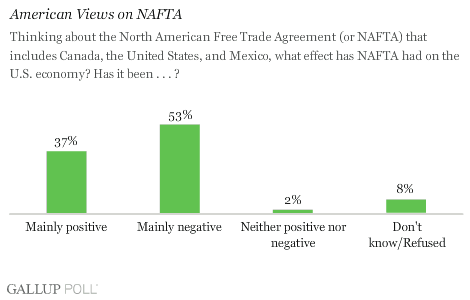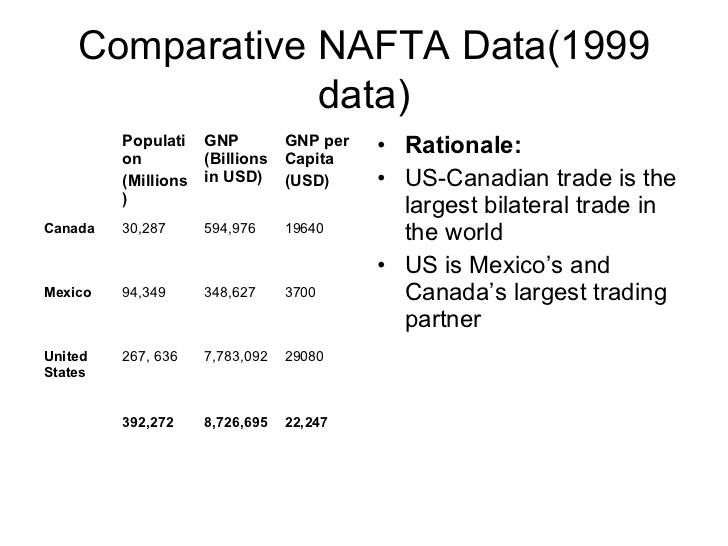Advantages of NAFTA Benefits and Positive Effects
Post on: 16 Март, 2015 No Comment

5 Benefits of NAFTA You May Not Even Realize
NAFTA lowers your grocery bill. Photo: Tetra Images/Getty Images
NAFTA created the world’s largest free trade area, which benefits the 450 million people within its borders. It created an economic powerhouse of $20.08 trillion, as measured by Gross Domestic Product (GDP ).
That’s because it linked the economies of the United States ( $16.72 trillion), Canada ($1.518 trillion) and Mexico ($1.845 trillion). This trade area is greater than the economic output of the 28 countries in the entire European Union. (Source: CIA World Factbook, Rank Order GDP. 2013 )
How NAFTA Provides Benefits
How does NAFTA boost trade? First, it eliminates all tariffs between the three countries (as of January 2008). This reduces inflation by decreasing the costs of imports.
Second, NAFTA creates agreements on international rights for business investors. This reduces the cost of trade, which spurs investment and growth especially for small businesses.
Third, NAFTA provides the ability for firms in member countries to bid on government contracts. This creates a level-playing field for all companies within its borders. It also helps to cut government budget deficits by allowing more competition and lower-cost bids.
Fourth, NAFTA protects intellectual properties. This boosts profits for innovative businesses by discouraging pirating. It also promotes foreign direct investment. because companies know that their rights will be protected by international law.
Benefits All Three Countries Enjoy
Between 1993-2012, trade between the three members quadrupled, from $297 billion to $1.6 trillion. (latest data available). This boosts economic growth. profits and jobs for all three countries. It also allows lower prices for consumers.
U.S. exports grew from $142 billion to $597 billion, making Canada and Mexico the top two purchasers of U.S. exports in 2013. Looked at another way, 33.3% of all U.S. exports went to these two countries. Exports from Canada and Mexico to the U.S. increased from $151 billion to $646 billion. (Source: Office of the US Trade Representative, NAFTA )
Benefits to the United States
NAFTA boosts U.S. economic growth by as much as .5% a year. Here’s five specific benefits that Americans enjoy:
1. Boosts U.S. Farm Exports - U.S. farmers were really helped by NAFTA. Food exports to Canada and Mexico grew 156%, compared to an increase of 65% to the rest of the world. To put this into perspective, farm exports to Canada and Mexico alone were greater than exports to the next six largest markets combined. It totaled $39.4 billion.
NAFTA increased farm exports because it eliminated high Mexican tariffs. Mexico is the top export destination for U.S.-grown beef, rice, soybean meal, corn sweeteners, apples and beans. It is the second largest export destination for corn, soybeans and oils. (Source: U.S. Foreign Agricultural Service, NAFTA )
2. Creates Trade Surplus in Services - NAFTA boosted U.S. service exports to Canada and Mexico from $25 billion in 1993 to a peak of $106.8 billion in 2007. However, the recession hit financial services hard, so services haven’t quite recovered. By 2009, they had only risen to $63.5 billion. By 2012, service exports had improved to $88.6 billion. (Source: USTR, Quantification of NAFTA Benefits ; NAFTA )
More than 40% of U.S. GDP is services, such as financial services and health care. These aren’t easily transported, so being able to export them to nearby countries is important. NAFTA eliminates trade barriers in nearly all service sectors, which are often highly regulated. NAFTA requires governments to publish all regulations, lowering hidden costs of doing business.

3. Lowers Oil Prices - The U.S. imported $144.2 billion in oil from Mexico and Canada. Thanks to greater U.S. production of its own shale oil, this figure is down from $157.8 billion in 2007.
Since NAFTA eliminates tariffs, oil prices are lower. This also reduces U.S. reliance on oil imports from the Middle East and Venezuela.
It’s especially important now that the U.S. no longer imports oil from Iran. Why? Mexico and Canada are friendly countries. Other oil-exporters, such as Venezuela and Iran, don’t think twice about using oil as a political chess piece. For example, both have started selling oil in currencies other than the petro-dollar. contributing to the decline in the dollar’s value.
4. Lowers Food Prices
NAFTA lowers food prices in much the same way. Imports totaled $39.4 billion in 2013 (up from $28.9 billion in 2009). This particularly helps lower the prices of fresh vegetables, chocolate, fresh fruit (except bananas) and beef. (Source: USTR, NAFTA Imports )
5. Steps Up Foreign Direct Investment - Since NAFTA was enacted, U.S. foreign direct investment (FDI) in Canada and Mexico more than tripled to $452 billion in 2012. This helps boost profits of U.S. businesses by giving them more opportunities to develop, and markets to explore.
Canadian and Mexican FDI in the U.S. grew to $240.2 billion, up from $219.2 billion in 2007. That means this much investment poured into U.S. manufacturing. insurance, and banking companies.
NAFTA reduces investors’ risk by guaranteeing they will have the same legal rights as local investors. Through NAFTA, investors can make legal claims against the government if it nationalizes their industry or takes their property by eminent domain. (Source: USTR, NAFTA Section Index ) Article updated October 29, 2014
Find Out More About NAFTA














